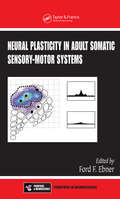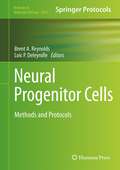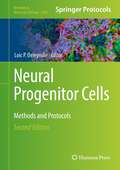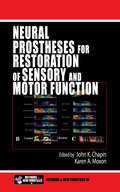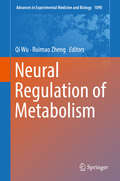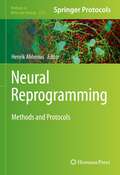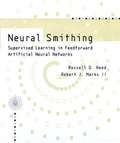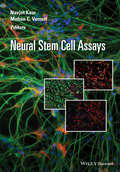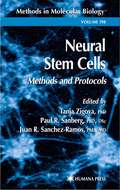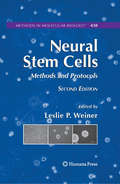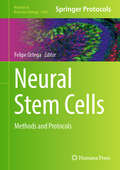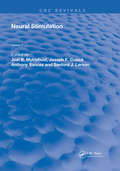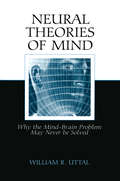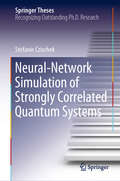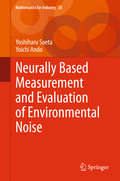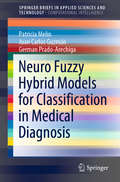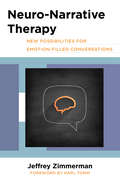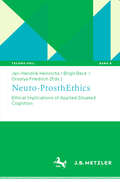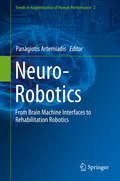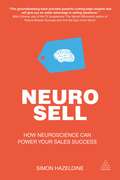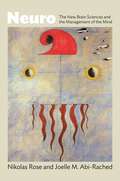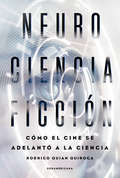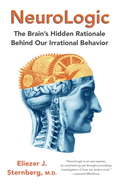- Table View
- List View
Neural Plasticity in Adult Somatic Sensory-Motor Systems (Frontiers in Neuroscience)
by Ford F EbnerSynthesizing current information about sensory-motor plasticity, Neural Plasticity in Adult Somatic Sensory-Motor Systems provides an up-to-date description of the dynamic processes that occur in somatic sensory-motor cortical circuits or somatic sensory pathways to the cortex due to experience, learning, or damage to the nervous system. The book e
Neural Progenitor Cells: Methods and Protocols
by Loic P. Deleyrolle Brent A. ReynoldsThe discovery of stem and progenitor cells in the adult mammalian CNS challenged the long standing "no new neuron" doctrine and opened the door to the potential for cell replacement therapy. The process from discovery to clinical applications can be long and tortuous, requiring rigorous steps involving standardized and precise protocols. Neural Progenitor Cells: Methods and Protocols is a collection of practical articles describing techniques used to study neural stem and progenitor cells. The volume also highlights the promise of stem cell-based therapeutic applications for CNS disorders. Written in the successful Methods in Molecular Biology series format, chapters include introductions to their respective topics, lists of the necessary materials and reagents, step-by-step, readily reproducible protocols, and notes on troubleshooting and avoiding known pitfalls. Authoritative and easily accessible, Neural Progenitor Cells: Methods and Protocols serves both professionals and novices with its well-honed methodologies.
Neural Progenitor Cells: Methods and Protocols (Methods in Molecular Biology #2389)
by Loic P. DeleyrolleThis updated edition collects cutting-edge techniques used to study neural stem and progenitor cells as well as the brain microenvironment. Featuring a wide range of technological advances in the study of neural stem cells, the volume highlights the promises of stem cell-based therapeutic applications for central nervous system ailments. Written for the highly successful Methods in Molecular Biology series, chapters include introductions to their respective topics, lists of the necessary materials and reagents, step-by-step, readily reproducible laboratory protocols, and tips on troubleshooting and avoiding known pitfalls. Authoritative and practical, Neural Progenitor Cells: Methods and Protocols, Second Edition serves as an invaluable resource for the next generation of neuroscientists as they develop innovative experimental paradigms and progress toward therapeutic applications in the field of neurobiology.
Neural Prostheses for Restoration of Sensory and Motor Function
by John K. Chapin Karen A. MoxonThe prospect of interfacing the nervous system with electronic devices to stimulate or record from neural tissue suggests numerous possibilities in the field of neuroprosthetics. While the creation of a "six million dollar man" may still be far into the future, neural prostheses are rapidly becoming viable theories for a broad range of patients wit
Neural Regulation of Metabolism (Advances in Experimental Medicine and Biology #1090)
by Qi Wu Ruimao ZhengThis book systemically describes the mechanisms underlying the neural regulation of metabolism. Metabolic diseases, including obesity and its associated conditions, currently affect more than 500 million people worldwide. Recent research has shown that the neural regulation of metabolism is a central mechanism that controls metabolic status physiologically and pathophysiologically. The book first introduces the latest studies on the neural and cellular mechanisms of hypothalamic neurons, hypothalamic glial cells, neural circuitries, cellular signaling pathways, and synaptic plasticity in the control of appetite, body weight, feeding-related behaviors and metabolic disorders. It then summarizes the humoral mechanisms by which critical adipocyte-derived hormones and lipoprotein lipase regulate lipid and glucose metabolism, and examines the role of the hypothalamus-sympathetic nerve, a critical nerve pathway from CNS to peripheral nervous system (PNS), in the regulation of metabolism in multiple tissues/organs. Furthermore, the book discusses the functions of adipose tissue in energy metabolism. Lastly, it explores dietary interventions to treat neural diseases and some of the emerging technologies used to study the neural regulation of metabolism. Presenting cutting-edge developments in the neural regulation of metabolism, the book is a valuable reference resource for graduate students and researchers in the field of neuroscience and metabolism.
Neural Reprogramming: Methods and Protocols (Methods in Molecular Biology #2352)
by Henrik AhleniusThis detailed book brings together a number of state-of-the-art protocols to generate different types of neural cells through the use of reprogramming technologies. Additionally, the volume explores different aspects of functional evaluation and applications of reprogrammed neural cells as well as in silico methods to aid reprogramming efforts. Written for the highly successful Methods in Molecular Biology series, chapters include introductions to their respective topics, lists of the necessary materials and reagents, step-by-step, readily reproducible laboratory protocols, and tips on troubleshooting and avoiding known pitfalls. Authoritative and cutting-edge, Neural Reprogramming: Methods and Protocols provides ample experimental experience and guidance for anyone, be it experienced researcher or beginner, to generate, validate, and apply reprogrammed neural cells in their research.
Neural Smithing: Supervised Learning in Feedforward Artificial Neural Networks
by Russell D. Reed Robert J. MarksArtificial neural networks are nonlinear mapping systems whose structure is loosely based on principles observed in the nervous systems of humans and animals. The basic idea is that massive systems of simple units linked together in appropriate ways can generate many complex and interesting behaviors. This book focuses on the subset of feedforward artificial neural networks called multilayer perceptrons (MLP). These are the mostly widely used neural networks, with applications as diverse as finance (forecasting), manufacturing (process control), and science (speech and image recognition). This book presents an extensive and practical overview of almost every aspect of MLP methodology, progressing from an initial discussion of what MLPs are and how they might be used to an in-depth examination of technical factors affecting performance. The book can be used as a tool kit by readers interested in applying networks to specific problems, yet it also presents theory and references outlining the last ten years of MLP research.
Neural Stem Cell Assays
by N. Kaur Mohan VemuriNeural stem cells offer a valuable model system for delineating the cellular and developmental processes in normal and diseased states of the central nervous system. In particular, neural stem cells have huge potential in regenerative medicine, owing to their expansion capability in culture and the ability to differentiate into multiple sub-neural lineages. Neural Stem Cell Assays provides a detailed and comprehensive review of the basic methods for neural stem cell cultures. Including an overview of progress in the field over the past decade, Neural Stem Cell Assays is a one-stop reference for consistent methods and reliable tools that span the entire assay work flow, from isolation or generation of neural stem cells to characterization, manipulation and final application of neural stem cells in disease paradigms such as Parkinson's disease, multiple sclerosis and amyotrophic lateral sclerosis. An excellent source of information for academic, pharmaceutical and biotechnology researchers who are new to the neural stem cell field, Neural Stem Cell Assays is an invaluable to experienced users who wish to integrate newly developed tools and technologies into their workflow. The book also covers important course material for students at the undergraduate and graduate level who are learning the basics of neural stem cell cultures, and differentiation to sub-neural lineages.
Neural Stem Cells
by Tanja Zigova Juan R. Sanchez-Ramos Paul R. SanbergIn Neural Stem Cells: Methods and Protocols, internationally recognized experts from academic, clinical, and pharmaceutical laboratories describe in great detail the most frequently used cellular, molecular, and electrophysiological methods to isolate, characterize, and utilize neural stem cells. These readily reproducible techniques introduce the various sources of stem/progenitor cells, provide a wide range of conditions for their culture, and make it possible to define their properties in culture. Additional techniques are designed to help researchers identify endogenous stem cells as well as exogenous stem cells after transplantation in the brain. The protocols range from the simplest methods of isolation and characterization of neural cell properties to such very sophisticated methods as characterizing gene expression, telomerase assays, and cell cycle kinetics.
Neural Stem Cells
by Leslie P. WeinerMany questions related to stem cell properties and neural stem cell lineage and differentiation still linger. This second edition revises and expands upon the successful first edition in order to provide the most current, cutting-edge methods of today for the scientists working to answer these questions. The use of these step-by-step, readily reproducible laboratory protocols will allow investigators to produce pure populations that can serve as a means of understanding the biology of neural stem cells and adapting them for transplantation into disease models. This is an excellent source of information and inspiration.
Neural Stem Cells: Methods and Protocols (Methods in Molecular Biology #2899)
by Felipe OrtegaThis detailed volume explores techniques for the study of neurogenic niches and neural lineage progression, specifically addressing major methodological challenges in studying neural stem cells (NSCs) and related cell populations, such as astrocytes, oligodendrocytes, and neurons. The chapters are organized to offer a comprehensive technical foundation, focusing on isolation and identification, monitoring, manipulation, analysis, and the exploration of potential therapeutic applications of NSCs. Written for the highly successful Methods in Molecular Biology series, chapters include introductions to their respective topics, lists of the necessary materials and reagents, step-by-step and readily reproducible laboratory protocols, and tips on troubleshooting and avoiding known pitfalls. Authoritative and practical, Neural Stem Cells: Methods and Protocols serves as an ideal guide for the scientific community and a broader audience interested in understanding neurogenic niches and the progression of neural lineages.
Neural Stimulation (Routledge Revivals)
by Joel B. Myklebust Anthony Sances Joseph F. Cusick Sanford J. LarsonFirst Published in 1985, this book offers a full, comprehensive investigation into Stimulation of the brain. Carefully compiled and filled with a vast repertoire of notes, diagrams, and references this book serves as a useful reference for Neurobiologists, and other practitioners in their respective fields.
Neural Stimulation (Routledge Revivals)
by Joel B. Myklebust Anthony Sances Joseph F. Cusick Sanford J. LarsonFirst Published in 1985, this book offers a full, comprehensive investigation into Stimulation of the brain. Carefully compiled and filled with a vast repertoire of notes, diagrams, and references this book serves as a useful reference for Neurobiologists, and other practitioners in their respective fields.
Neural Theories of Mind: Why the Mind-Brain Problem May Never Be Solved
by William R. UttalIn this fascinating book, William R. Uttal raises the possibility that, however much we learn about the anatomy and physiology of the brain and psychology, we may never be able to cross the final bridge explaining how the mind is produced by the brain. Three main classes of mind-brain theory are considered and rejected: field theories, because they are based on a superficial analogy; single cell theories, because they emerge from a massive uncontrolled experimental program; and neural net theories, because they are constrained by combinatorial complexity.To support his argument, Uttal explores the empirical and conceptual foundations of these theoretical approaches and identifies flaws in their fundamental logic. The author concludes that the problems preventing solution of the mind-brain problem are intractable, yet well within the confines of natural science.
Neural-Network Simulation of Strongly Correlated Quantum Systems (Springer Theses)
by Stefanie CzischekQuantum systems with many degrees of freedom are inherently difficult to describe and simulate quantitatively. The space of possible states is, in general, exponentially large in the number of degrees of freedom such as the number of particles it contains. Standard digital high-performance computing is generally too weak to capture all the necessary details, such that alternative quantum simulation devices have been proposed as a solution. Artificial neural networks, with their high non-local connectivity between the neuron degrees of freedom, may soon gain importance in simulating static and dynamical behavior of quantum systems. Particularly promising candidates are neuromorphic realizations based on analog electronic circuits which are being developed to capture, e.g., the functioning of biologically relevant networks. In turn, such neuromorphic systems may be used to measure and control real quantum many-body systems online. This thesis lays an important foundation for the realization of quantum simulations by means of neuromorphic hardware, for using quantum physics as an input to classical neural nets and, in turn, for using network results to be fed back to quantum systems. The necessary foundations on both sides, quantum physics and artificial neural networks, are described, providing a valuable reference for researchers from these different communities who need to understand the foundations of both.
Neurally Based Measurement and Evaluation of Environmental Noise
by Yoichi Ando Yoshiharu SoetaThis book deals with methods of measurement and evaluation of environmental noise based on an auditory neural and brain-oriented model. The model consists of the autocorrelation function (ACF) and the interaural cross-correlation function (IACF) mechanisms for signals arriving at the two ear entrances. Even when the sound pressure level of a noise is only about 35 dBA, people may feel annoyed due to the aspects of sound quality. These aspects can be formulated by the factors extracted from the ACF and IACF. Several examples of measuring environmental noise--from outdoor noise such as that of aircraft, traffic, and trains, and indoor noise such as caused by floor impact, toilets, and air-conditioning--are demonstrated. According to the noise measurement and evaluation, applications for sound design are discussed. This book provides an excellent resource for students, researchers, and practitioners in a wide range of fields, such as the automotive, railway, and electronics industries, and soundscape, architecture, and acoustics.
Neuro Fuzzy Hybrid Models for Classification in Medical Diagnosis (SpringerBriefs in Applied Sciences and Technology)
by Patricia Melin German Prado-Arechiga Juan Carlos GuzmánThis book is focused on the use of intelligent techniques, such as fuzzy logic, neural networks and bio-inspired algorithms, and their application in medical diagnosis. The main idea is that the proposed method may be able to adapt to medical diagnosis problems in different possible areas of the medicine and help to have an improvement in diagnosis accuracy considering a clinical monitoring of 24 hours or more of the patient.In this book, tests were made with different architectures proposed in the different modules of the proposed model. First, it was possible to obtain the architecture of the fuzzy classifiers for the level of blood pressure and for the pressure load, and these were optimized with the different bio-inspired algorithms (Genetic Algorithm and Chicken Swarm Optimization). Secondly, we tested with a local database of 300 patients and good results were obtained. It is worth mentioning that this book is an important part of the proposed general model; for this reason, we consider that these modules have a good performance in a particular way, but it is advisable to perform more tests once the general model is completed.
Neuro-Narrative Therapy: New Possibilities For Emotion-filled Conversations
by Jeffrey ZimmermanBringing interpersonal neurobiology and narrative therapy together. Narrative therapy understands storytelling as the way we make sense of ourselves and life experience. Many non-narrative therapists have expressed great admiration and interests in the politics the work exposes, the way it brings in the socio-political context, and the way it centers clients. Yet despite its popularity and success as a useful therapeutic approach, Narrative Therapy has been criticized as minimizing and failing to develop any extended discussion of something vital to our lives: emotion. Neuro-Narrative Therapy attempts to redress this problem by taking us first through standard Narrative practices, and then showing how and where affect can be brought in and even privileged in the work. After situating the evolution of Narrative Therapy in its historical context, the book provides information about why emotions should be given an important place in the work. Specifically, it brings ideas and implications of some of the most exciting and novel theories—interpersonal neurobiology and affective neuroscience—to the practice of Narrative Therapy. Readers will learn about the growing emphasis on the right brain, and how an understanding of the ways in which emotion and affect are manifested by the brain can help us help our clients. The possibilities for this new approach are many: a freer discussion of the emotional side of your clients; an understanding and sensitivity to the relation of body and mind; attention to how the therapeutic relationship of our clients can become a resource in treatment and a renewed understanding of how our memories—and thus our stories about our lives—develop in early childhood and beyond. For any therapist working in the area of Narrative Therapy, and for any interested in the emerging understandings that science is bringing to appreciating how our brains develop with and among each other, this book has something to offer. Combining the neuro- and the narrative, as Jeffrey Zimmerman has done here, will create a new direction in Narrative Therapy, one in which our brain and body work together, inviting a more direct and effective engagement with clients.
Neuro-ProsthEthics: Ethical Implications of Applied Situated Cognition (Techno:Phil – Aktuelle Herausforderungen der Technikphilosophie #9)
by Jan-Hendrik Heinrichs Birgit Beck Orsolya FriedrichThe volume focusses on the ethical dimensions of the technological scaffold embedding human thought and action, which has been brought to attention of the cognitive sciences by situated cognition theories. There is a broad spectrum of technologies co-realising or enabling and enhancing human cognition and action, which vary in the degree of bodily integration, interactivity, adaptation processes, of reliance and indispensability etc. This technological scaffold of human cognition and action evolves rapidly. Some changes are continuous, some are eruptive. Technologies that use machine learning e.g. could represent a qualitative leap in the technological scaffolding of human cognition and actions. The ethical consequences of applying situated cognition theories to practical cases had yet to find adequate attention and are elucidated in this volume.
Neuro-Robotics
by Panagiotis ArtemiadisNeuro-robotics is one of the most multidisciplinary fields of the last decades, fusing information and knowledge from neuroscience, engineering and computer science. This book focuses on the results from the strategic alliance between Neuroscience and Robotics that help the scientific community to better understand the brain as well as design robotic devices and algorithms for interfacing humans and robots. The first part of the book introduces the idea of neuro-robotics, by presenting state-of-the-art bio-inspired devices. The second part of the book focuses on human-machine interfaces for performance augmentation, which can seen as augmentation of abilities of healthy subjects or assistance in case of the mobility impaired. The third part of the book focuses on the inverse problem, i. e. how we can use robotic devices that physically interact with the human body, in order (a) to understand human motor control and (b) to provide therapy to neurologically impaired people or people with disabilities.
Neuro-Sell
by Simon HazeldineAnyone involved in sales faces huge challenges these days, from fierce global competition, pressure on margins, difficulties of getting time with prospective buyers and the power of internet-savvy buyers. To succeed in sales, you need something more than the traditional techniques. Neuro-Sell gives you the edge through a brain-based perspective, process and approach to selling that is sensitive to what's going on in your customers' minds. Learn how to really relate to your prospects and sell in a way that is comfortable for both buyer and seller. Understand the importance of the unconscious and find out how to get below the surface level of what people say to recognise what they really mean. Develop your skills in building sales relationships with the four main types of buyer by fully understanding their needs. And discover the five stages of neuro-negotiating that will see your sales rates rocket.
Neuro: The New Brain Sciences and the Management of the Mind
by Nikolas Rose Joelle M. Abi-RachedHow the new brain sciences are transforming our understanding of what it means to be humanThe brain sciences are influencing our understanding of human behavior as never before, from neuropsychiatry and neuroeconomics to neurotheology and neuroaesthetics. Many now believe that the brain is what makes us human, and it seems that neuroscientists are poised to become the new experts in the management of human conduct. Neuro describes the key developments—theoretical, technological, economic, and biopolitical—that have enabled the neurosciences to gain such traction outside the laboratory. It explores the ways neurobiological conceptions of personhood are influencing everything from child rearing to criminal justice, and are transforming the ways we "know ourselves" as human beings. In this emerging neuro-ontology, we are not "determined" by our neurobiology: on the contrary, it appears that we can and should seek to improve ourselves by understanding and acting on our brains.Neuro examines the implications of this emerging trend, weighing the promises against the perils, and evaluating some widely held concerns about a neurobiological "colonization" of the social and human sciences. Despite identifying many exaggerated claims and premature promises, Neuro argues that the openness provided by the new styles of thought taking shape in neuroscience, with its contemporary conceptions of the neuromolecular, plastic, and social brain, could make possible a new and productive engagement between the social and brain sciences.Copyright note: Reproduction, including downloading of Joan Miro works is prohibited by copyright laws and international conventions without the express written permission of Artists Rights Society (ARS), New York.
NeuroCienciaFicción: Cómo el cine se adelantó a la ciencia
by Rodrigo Quian QuirogaEl neurocientífico Rodrigo Quian Quiroga cuenta cómo la neurociencia está llegando adonde solo creíamos que podía llegar la ciencia ficción: borrar o implantar recuerdos, implantar prótesis neuronales o la posibilidad de leer la mente ya no pertenecen a la imaginación de un guionista, se han vuelto realidad. El cine imagina más allá de lo posible, suele anticiparse a su época y propone avances fascinantes y disruptivos. En Inception, un grupo de conspiradores implanta falsos recuerdos; en Hasta el fin del mundo, un científico alocado llega a leer los sueños; en 2001: Odisea del espacio, una supercomputadora siente y piensa como una persona. Pero así como el cine de ciencia ficción se apoya en los últimos avances de la ciencia, la ciencia también se nutre de la prolífica imaginación de los cineastas y de pronto vemos que es una realidad aquello que alguna vez fue fantasía: implantar memorias manipulando a voluntad grupos de neuronas a través de la optogenética , leer la mente durante el sueño a partir de avanzados algoritmos de decodificación, o lograr que las computadoras superen el pensamiento humano en infinidad de tareas mediante redes neuronales profundas; logros científicos concretos de los últimos años. El físico y neurocientífico Rodrigo Quian Quiroga, director del Centro de Neurociencia de Sistemas en la Universidad de Leicester en Inglaterra, propone un cruce entre el arte, la ciencia y la filosofía y se pregunta hasta dónde ha llegado el cine con sus fabulosas especulaciones y cuántas de éstas se están materializando en los laboratorios del mundo. Para eso, analiza cómo la ciencia está logrando lo que hace décadas parecía imposible, y cómo estos avances nos llevan a replantearnos las grandes preguntas filosóficas que el hombre viene haciéndose desde siempre.
NeuroLogic
by Eliezer SternbergA groundbreaking investigation of the brain's hidden logic behind our strangest behaviors, and of how conscious and unconscious systems interact in order to create our experience and preserve our sense of self. From bizarre dreams and hallucinations to schizophrenia and multiple personalities, the human brain is responsible for a diverse spectrum of strange thoughts and behaviors. When observed from the outside, these phenomena are often written off as being just "crazy," but what if they were actually planned and logical? NeuroLogic explores the brain's internal system of reasoning, from its unconscious depths to conscious decision making, and illuminates how it explains our most outlandish as well as our most stereotyped behaviors. From sleepwalking murderers, contagious yawning, and the brains of sports fans to false memories, subliminal messages, and the secret of ticklishness, Dr. Eliezer Sternberg shows that there are patterns to the way the brain interprets the world---patterns that fit the brain's unique logic. Unraveling these patterns and the various ways they can be disturbed will not only alter our view of mental illness and supernatural experience, but will also shed light on the hidden parts of ourselves. (With black-and-white illustrations throughout.)From the Hardcover edition.
NeuroLogic: The Brain's Hidden Rationale Behind Our Irrational Behavior
by Eliezer SternbergA groundbreaking investigation of the brain's hidden logic behind our strangest behaviors, and of how conscious and unconscious systems interact in order to create our experience and preserve our sense of self. From bizarre dreams and hallucinations to schizophrenia and multiple personalities, the human brain is responsible for a diverse spectrum of strange thoughts and behaviors. When observed from the outside, these phenomena are often written off as being just "crazy," but what if they were actually planned and logical? NeuroLogic explores the brain's internal system of reasoning, from its unconscious depths to conscious decision making, and illuminates how it explains our most outlandish as well as our most stereotyped behaviors. From sleepwalking murderers, contagious yawning, and the brains of sports fans to false memories, subliminal messages, and the secret of ticklishness, Dr. Eliezer Sternberg shows that there are patterns to the way the brain interprets the world---patterns that fit the brain's unique logic. Unraveling these patterns and the various ways they can be disturbed will not only alter our view of mental illness and supernatural experience, but will also shed light on the hidden parts of ourselves. (With black-and-white illustrations throughout.)From the Hardcover edition.
